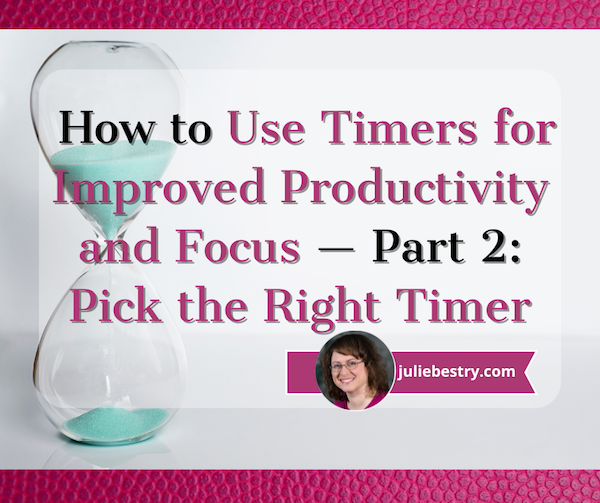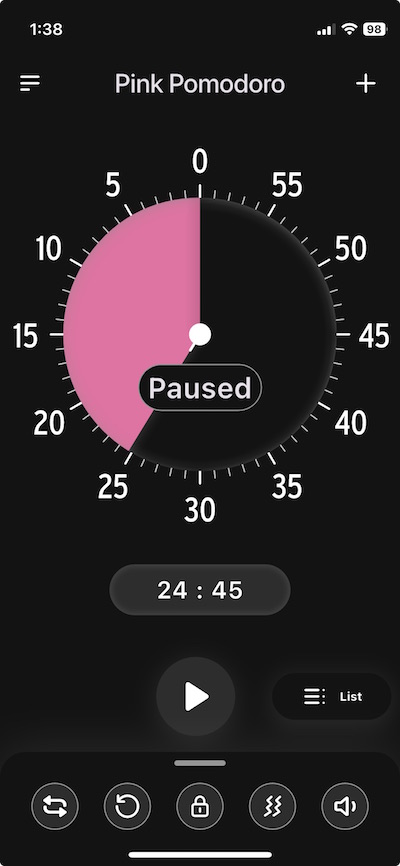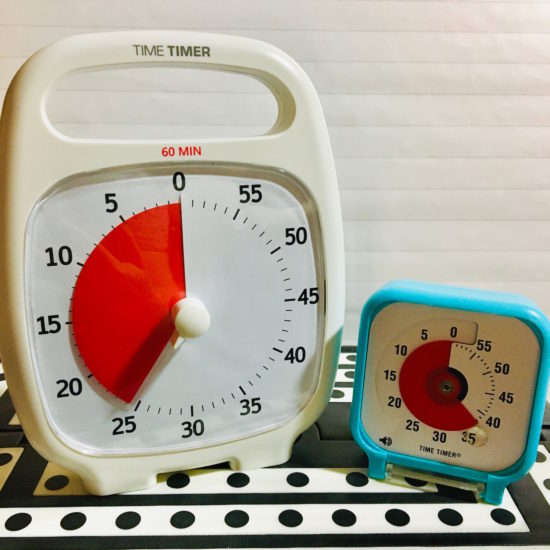Follow Me
Latest Posts
- How to Use Timers for Improved Productivity — Part 5: Hybrid Timers and Bonus Material
- How to Use Timers for Improved Productivity and Focus — Part 4: Digital Timers
- How to Use Timers for Improved Productivity and Focus — Part 3: Tangible Timers
- How to Use Timers for Improved Productivity and Focus — Part 2: Pick the Right Timer
- How to Use Timers for Improved Productivity and Focus — Part 1
Search Best Results Organizing
Subscribe to the Paper Doll Blog via Email
How to Use Timers for Improved Productivity and Focus — Part 2: Pick the Right Timer
Posted on: April 14th, 2025 by Julie Bestry | 8 Comments

Future, noun. That period of time in which our affairs prosper, our friends are true, and our happiness is assured.
~ Ambrose Bierce, The Devil’s Dictionary
Bierce’s satire aside, the future is unpredictable, and no matter how speedily we attempt to get there, by the time we arrive where the future was, it has moved off again, always out of our grasp. Time is slippery that way, and the only control we have over time is how and what we choose to do with it.
Last week, in How to Use Timers for Improved Productivity and Focus — Part 1, we looked at a variety of ways to use timers to help us be more focused and productive at home and at work, for ourselves on our own or with our work teams or families.
Today, we’ll look at the qualities of what makes a “good” timer, in general and for you, specifically. A lot more goes into your choice than just being able to keep track of time as it keeps on ticking, ticking, ticking into the future.
WHAT MAKES A GOOD TIMER?
You could use an hourglass for noting the passage of time: two (attached) transparent glass bulbs, voluminous grains of sand, and gravity. Hourglasses have existed since the 16th century BCE and offer an somewhat accurate way of time keeping, whether to decorate your mantle or play a mean game of Boggle.

Unfortunately, an hourglass requires you to stop what you are doing, look over at it, and be able to gauge what those collective grains of sand mean.
It’s not very helpful for those who hyper-focus (as they’d never remember to look at the hourglass in the first place) in order to pace themselves. Worse, for those who are prone to easy distraction, hourglasses are silent; by the time you discern the ratio of sand on the top to sand on the bottom and calculate how much time you have left, you’ll have forgotten what you were writing or doing in the first place!
Hourglasses also lack the precision you’ll need if you want to make a soufflé.
So, let’s first look at the basic characteristics of a good timer.
A Good Timer Must Be Simple
It doesn’t matter whether you use a digital timer (or app) or an analog clock timer, though there are features of each style that will make you more likely to enjoy the experience and therefore stick to it.
The first essential principle is that a timer must be easy — preferably intuitive — to operate. You shouldn’t need a thirty-page manual or a YouTube video to figure out how it works.
A Good Timer Should Offer A Bonus
If a timer doesn’t offer something more than or different from what you’ve already got, why are you looking for something new?
Why buy a physical timer that’s not materially different from the kitchen timer on your stove?
If a turn of a dial and a loud, angry buzz will suffice for you, if you only need one timer set at a time, if all your work is done in proximity to the kitchen — why look further?
Similarly, why download an app that does what your phone’s countdown timer can already do?
We professional organizers caution clients that buying more and different bins and storage items won’t solve problems if you don’t purge excess and sort what remains. Similarly, if you’re not using the various timer apps you’ve already downloaded, and there’s nothing materially different about the ones you’re coveting in the app store, back away from the screen!
If a timer can’t do anything but replicate the features you already have available to you, it’s not a benefit; it’s clutter. So, either identify what’s not already satisfying about the timers you have at your disposal, or investigate what else is prompting you to keep shopping for a solution.
A Good Timer Integrates with What You Already Have
A timer should have the capacity to work with your calendar or to-do list, if necessary. You shouldn’t have to learn an entirely new app’s system for scheduling, time blocking, or task completion. If you’re using your timer in conjunction with a virtual meeting, it should integrate with the meeting software (as we discussed last week).
Does the timer you’re considering play nicely with whatever you’re already doing, or does it force you to jump through hoops.
- Got a physical timer that fits in with your desk vibe, so it doesn’t look like a leftover from your 7th-grade math class? Stellar! But if your tangible timer topples off your shelf or is too big to fit in your school or work bag, you’re going to leave it behind.
- Do you need a timer app that syncs with your calendar or to-do list, or at least fits with your digital-only life?
There’s no best timer solution because we all need and want different things. The key to your timer helping you succeed is if it helps reinforce routines and habits you already love (or at least are learning to try to love).
The key to your timer helping you succeed is if it helps reinforce routines and habits you already love (or at least are learning to try to love). Share on XA Good Timer Shows You the Shape of Time
Time is measured in hours, minutes, seconds, even milliseconds, and yet it can seem amorphous. With the exception (as we’ll discuss later) of those who feel anxious working against a visible countdown clock, the prospect of using a timer delivers a great advantage: helping you see the progress of time at a glance.
You want a visual cue that says, “Look! Time is passing… but don’t panic,” — not one that leaves you feeling like Indiana Jones watching the stone door close.
The less cognitive effort and physical attention it takes to check in, the more you stay in flow. And the more you stay in the flow, focused on your goals, the more productive you will be. The timer is there to help you be motivated to start working, and then to prompt you step away when it’s time to rest.
When you look away to see if here’s any time left on the timer, you should be able to quickly refocus on your work. That means your time remaining needs to be displayed clearly and cause no confusion so you can slip seamless back into task mode.
Conversely, if you’ve been resting (or goofing off) and need to get back to work on the next Pomodoro, or must keep the roast from turning into a charcoal briquette, you’ll want a loud (enough) yoo-hoo to help you transition to the next stage!
A Good Timer Should Be Frictionless
If a timer is annoying or awkward to use, you’re going to find reasons to avoid using it. Setting a timer should be as easy as turning a dial or scrolling to the correct time and pushing a button or toggling it to ON.
A tangible timer should either be mechanical and battery-free, or the batteries should be easy to replace with the kinds of batteries you already tend to have on hand, usually AA or AAA. (A client of mine recently bought a large number of small flashlights to keep around her house in case of a power outage; she didn’t realize that they required 3.7 volt lithium ion batteries, so she had to purchase special batteries and a charger. Always check what kind of batteries a gadget requires!)
The annoying truth is that humans are willing to go to ridiculous levels of effort to avoid easy solutions to their problems.
Look at the number of children (and adult significant others who act like children) who won’t lift the lid off the laundry hamper in order to put dirty clothes inside. They’ll pile laundry up on top or just drop things on the floor rather than taking that teeny bit of one-second, lift-the-lid effort to use the hamper.
Thus, anything that creates friction — batteries that die quickly, an app that requires you to log in every time you want to use it — is going to slow you down or prompt you to avoid using it altogether.
When you're looking for a timer to help you be more productive, anything that creates friction — batteries that die quickly, and app that requires you to log in every time — is going to slow you down or prompt you to avoid using it… Share on XA Good Timer Is Process-Agnostic
No, this has nothing to do with timing a Sunday morning or Friday night sermon. Rather, whatever timer you choose should let you develop your own personal system. Francesco Cirillo, the inventor of the Pomodoro Technique, used a process of trial and error to develop the idea of working in no more than four 25-minute sessions with a five-minute break between each.
It’s a popular strategy and definitely helps conquer procrastination. But as convenient as 25/5 Pomodoros are for students struggling to hunker down and study or work on problem sets, these are not magic productivity numbers.
If I wrote this blog in 25-minute chunks, I’d likely be interrupting myself just as I started to get my creative mojo flowing. Instead, I tend to use modified Pomodoros or the 52/17 Method when I’m writing because I can get into more of a flow. However, for boring admin work like accounting or filing, I’ll often opt for 15-minute time blocks because I know I will try to “beat the clock” to get as many tasks as possible done in an hour.
As we’ll see, a timer needs to fit the way you want to use it for you to achieve maximum productivity.
HOW TO IDENTIFY THE BEST TIMER FOR YOUR NEEDS AND PERSONALITY
Beyond the basics of a good timer, what makes a timer fit your path to productivity depends largely on your style and the kind of work you’re trying to accomplish. As we discussed last week, this could involve anything from a team brainstorming meeting at work to getting the laundry folded before company comes, preventing hyper-focus when dealing with email or just getting out the door on time.
Even with all of the basics in play, there are a variety of customizations that will make-or-break your timer experience.
Aesthetics of a Timer
A timer, whether for strict Pomodoros or just to make sure you don’t let the pasta water boil over, needs to invite you to use it.
If you’re a no-nonsense type of person, you may want a digital timer that lets you pick the work and break durations quickly, with no fuss, and that’s all!
If your aesthetic tastes tend toward the cozy and traditional, you might prefer something nostalgic like the traditional tomato-shaped timer; if you have a cute and twee aesthetic, your ideal timer may look like this:

Nuoswek Mechanical kitchen timer
If you’re opting for a digital timer, you might want to be able to adjust the brightness and color. Some people can’t abide the standard screen for a digital app and immediately opt for dark mode; others want a timer set to their personal color aesthetic.
For example, when I’m in the Time Timer app, even though I almost always prefer to use light mode on my screens for writing and surfing, I like dark mode for timers. For me, that makes the timer blend into the background and I can quickly regain my focus after checking the timer.
Similarly, I usually select pink or purple timers, but I have clients who color-code timers for specific tasks: red timers for high-impact work, blue timers for meditation, green for exercise, and so on.

Perhaps the visual aspects of a timer are less important to you than the auditory ones. Maybe you prefer your timer to have an alarm or musical alert that won’t be jarring.
In the comments on last week’s post, my colleague Sabrina Quairoli noted that using timers can make people anxious. That anxiety can come from the concept of a timer itself, or from the sound the timer makes. If it’s the sound, it’s a matter of selecting a timer with customizable auditory options.
If the concept of a timer with the time ticking down quickly makes you antsy, you’re going to want to avoid a digital timer showing the seconds slipping away as if you’re trying to make your Oscar acceptance speech before the orchestra plays you off the stage.
Instead, opt for a timer with a soothing visual approach, one that doesn’t show the second-by-second passage of time. Rather, select one that indicates the overarching passage of time (the minutes or chunks of time) without the more granular metrics.
For example, all of Time Timer‘s analog timers that use a colored disk would be appropriate for a more gentle approach to illustrating the passage of time.

Note: The TimerTimer Twists, have both an analog and digital countdown; if seeing those seconds disappear stresses you out, skip those versions.
Customizability without complexity
You want a timer that will adjust to your rhythm, whether you’re a 25-minute Pomodoro purist for blogging or a “give me 43 minutes because that’s how long (without commercials) it took Columbo to solve a crime” computer code bug tracker.
Consider whether you just want your timer to just block time and alert you when your scheduled time is up, or if you prefer it to automatically set alternating work and rest intervals. Some timers will let you set any increments you want, at least up to 99 minutes. Others are fixed, and will only let you set the timer in five minute increments.
If you’re hoping to use the timer to for cooking, exercising, or for medical purposes (like the seconds after self-administering an injection before you can remove the needle, or the number of seconds to do breathing exercises), you’ll want to be as granular as possible, so seconds and minutes will be key.
Teachers and parents may prefer short-format timers to help kids see and feel the duration of time: of five minutes in time-out, ten minutes of quiet reading, fifteen minutes until bedtime. Meanwhile, knowledge workers will likely need larger chunks of measurable time, from 25 minutes to two hours.
Affective Design Customization
Affective design is an approach that focuses on creating products, services, and experiences that evoke emotions (or, for some purposes, avoid evoking the wrong emotions) in users.
In other words, you want to pick a timer (or selection of timers) with emotionally-supportive vibes (as the kids say). Think about the reason you’re setting up your timer, and how you want to feel while you’re working and, in particular, how you want to feel when the timer goes off and you’re being alerted to the need to transition.
Some people want Mister Rogers with a gentle ding or buzz to remind them that, “Hey, friend, you’re doing great, and you deserve the reward of a five minute break.” (Bonus material: Mr. Rogers Neighborhood episode: Waiting for Time to Pass.)
Others want Judge Judy slamming the gavel to say, “Time’s up, sweetie!” in so harsh a manner that there’s no chance you’ll go back to TikTok or forget to use the restroom if you’ve been hyper-focusing way too long.
As we’ve alluded, may want to adjust your sound options to create the best vibe. Do you want to be be shaken to attention to make sure you’ll stop doomscrolling and get out the door to pick your kid up from ballet? Or might you prefer a soothing trill of music to signal the end of a writing session (without a din) so that you won’t forget that brilliant turn of phrase you were just starting to write?
One-and-done or loop-de-loop?
Just as you may need to consider how in-your-face a timer should be to help you be as productive as possible, you also should think about how attentive a timer you want.
If you’re cooking something and are afraid either your body or your mind will stray, a one-and-done timer will suffice.
Conversely, there are a number of reasons you might want to set repeated or looping cycles, such as if:
- you’re training yourself to tidy up your work area for five minutes every hour
- you want to take breaks between sessions, whether you’re doing a 25/5 Pomodoro, following the 52/17 Method, or considering any of the other productivity techniques in Frogs, Tomatoes, and Bees: Time Techniques to Get Things Done.
- you’re following the advice in Take a Break — How Breaks Improve Health and Productivity and following the 20-20-20 Rule for your vision. (Every 20 minutes, look 20 feet away for 20 seconds to prevent eye strain!)
A looping function is especially nice if you tend to overstay your planned breaks between tasks. Setting a repeated work/break timer prevents “I’ll take a five-minute break” from becoming a Netflix bender.
You may not always want to create repetitive cycles, but a timer that can repeat or remind you to reset will help automate your habits. (Generally, you’ll need a digital timer if you want cycles to loop automatically.)
Discretion is the better part of timing
In addition to considering what’s the best timer for your own situation, you may need to seek one with discreet modes for the benefit of not disturbing the people around you. For example:
 Sleeping baby by Ivone De Melo
Sleeping baby by Ivone De Melo
- sleeping babies (or easily startled pets)
- roommates or housemates (particularly those on different sleep, class, or work schedules)
- co-workers in cubicles or open-format offices
- fellow library or coffee house patrons
In such situations, you’ll want a timer with the stealth of a Mission: Impossible agent (not the drama of a WWE competitor making a grand entrance.
If you often find yourself working (or otherwise needing to focus) while in the company of others with different focus agendas, consider whether it might be to your advantage to find a timer with alternatives to an audible “time’s up” alert. A gentle blink or color shift can be just as effective as a sound.
Picking a timer for someone else
We all want the timer equivalent of Mary Poppins — practically perfect in every way — but the truth is that we will always have to consider the task involved and personality of the user. Additionally, you may need to identify timer solutions for people with special auditory or visual challenges (like the Time Timer BRAILLE 8”) or medical needs.
In other words, the timer your seven-year-old needs to focus while doing math homework may be very different from what your fifteen-year-old needs to get up from an hour of gaming and leave for band rehearsal.
And both of them may need something very different from what you need from a timer at work or that Grandpa needs to remember to take his medication after dinner.
None of this means you have to spent a fortune on timers; just knowing the advantages of particular features will allow you to discern what will work best. In the next post in this series, we’ll examine traditional and novel timers for improving productivity and yielding the just right amount of focus.
What timer features are the most important to you? How does do these change depending on your work or life contexts?
Paper Doll Post:




Your post inspired me, but probably not in the way you’d expect. I’ve never felt the need to use a timer, except to keep track of billable hours, as well as the amount of time spent on admin and other tasks.
I’ve been using Toggl for all of this, but my invoicing program has a built-in timer, so I could use it instead for my billable hours, which would save me a chunk of time at the end of the month. I would then only need Toggl for the other stuff. That’s two timers instead of one, the exact opposite of what you recommend, but I think it makes sense in this case. Do you agree?
Any inspiration is good, no matter what you choose to do with it! 😉
And I’m not against using two timers; as I said, you just don’t want to acquire a new timer that doesn’t offer you anything more or different from what you already have. The built-in invoicing program’s timer makes you more productive by saving time with your invoicing, so that’s a win! It makes sense AND it agrees with my overarching point, too, that you pick solutions that work FOR YOU!
Win-win-win! (And thank you for reading and sharing your experiences!)
I love timers and use multiple ones. At my desk I have the Time Timer. This can help me track how much time I have left to work on a project without any sound but the ping that the time is up. I love the visual tracking that allows me to see how much time is left. I also used this timer when I was a special education schoolteacher. I could set one on or near the desk of a student who had to leave for speech therapy during a class hour. I used it for standardized tests so the students could see how much time was left (and I also put a mark on it for now it the time to stop analyzing your answers and go ahead and just mark the remaining responses since unmarked responses were automatically wrong).
But I set alarms on my phone for times that I absolutely must do a task or get out the door. I use kitchen timers to track cooking.
I love my timers.
Oooh, I think you could write an entire blog post about how teachers (including homeschooling parents) can make use of timers for student and classroom productivity!
I love that you love your timers. I primarily use my iPhone timer or the TimeTimer app for desk work or cooking. (I’m not easily distracted under most circumstances, but cooking bores me and I can see myself walking away from the stove until I hear the pasta boiling over!) With clients, I primarily use a physical timer and I have a few different styles, which I’ll share next week.
Thank you for reading and sharing your experiences!
This is an excellent point, and is valid for anything we buy: “If a timer can’t do anything but replicate the features you already have available to you, it’s not a benefit; it’s clutter.”
This statement made me laugh: “humans are willing to go to ridiculous levels of effort to avoid easy solutions to their problems.” It’s SO TRUE. What is it with us??
You’ve given a lot more though to timers than I ever have for sure. I love all of these points. If we were this thoughtful with all acquisitions, we would probably acquire less!
I had an interesting timer situation with a client. The husband wanted an old, white kitchen timer. He had used one for years, and wanted to replace it. We had a harder than expected time finding something that to him was “the same.” This simply adds the perspective that if you used a timer in the past that you liked, try to figure out exactly what you liked about it, and potentially be willing to work hard to replace it. If this guy didn’t get something close enough, he wasn’t going to use it.
Thank you for highlighting the first statement; before I buy any non-consumable item, that’s always my first question. What does it (or can it) do that I what I have isn’t already doing? And it’s the question I ask clients. It’s not that we don’t have a right to acquire fun, new things just because they are fun or new, but if novelty is all they offer, then letting go of what’s not novel is the next step. Otherwise? Clutter!
I’m glad you laughed at how we humans are so likely to avoid the easy answer. Clean the kitchen after every meal and you’ll never have to scrub. Nope. Put the laundry IN the hamper. Nope. Pay the bills as soon as you get paid so you’ll know how much you have left for play money. Nope.
And yes, when I decided I wanted to write about some new and nifty timers I saw, I realized that I basically felt like we needed a full-on treatise on the bounty that is the world of timers…so I made it! But next week where all the fun pictures come in.
I absolutely understand your client; he’s the opposite of the folks who want something new and different. He wants something new and THE SAME (like Lorelei Gilmore ending up buying an exact replica of her Jeep to serve as an “organ donor” for her old Jeep). Did you find a white timer he liked?
I love this statement, “The less cognitive effort and physical attention it takes to check in, the more you stay in flow.” Any distractions can make one not want to use it, or one may start, but it may be frustrating over time, and they decide not to continue with it. This is an enjoyable post; thanks for sharing your thoughts.
Isn’t that the truth? It’s just like the rule of backing up; you want it to be automatic, because if you don’t automate the process and have to think about, you’ll use your energy to think and avoid doing it instead of for actually doing it.
And thanks for giving me the idea to write about anxiety-provoking aspects of timers; I made a point of paraphrasing and linking to your site.